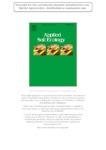Use este identificador para citar ou linkar para este item:
http://www.alice.cnptia.embrapa.br/alice/handle/doc/905709Registro completo de metadados
| Campo DC | Valor | Idioma |
|---|---|---|
| dc.contributor.author | CARVALHO, F. de | pt_BR |
| dc.contributor.author | SOUZA, F. A. de | pt_BR |
| dc.contributor.author | CARRENHO, R. | pt_BR |
| dc.contributor.author | MOREIRA, F. M. de S. | pt_BR |
| dc.contributor.author | JESUS, E. da C. | pt_BR |
| dc.contributor.author | FERNANDES, G. W. | pt_BR |
| dc.date.accessioned | 2017-06-06T23:51:24Z | - |
| dc.date.available | 2017-06-06T23:51:24Z | - |
| dc.date.created | 2011-11-11 | pt_BR |
| dc.date.issued | 2012 | pt_BR |
| dc.identifier.citation | Applied Soil Ecology, Amsterdam, v. 52, p. 9-19, 2012. | pt_BR |
| dc.identifier.uri | http://www.alice.cnptia.embrapa.br/alice/handle/doc/905709 | pt_BR |
| dc.description | The high diversity in rupestrian field vegetation has been attributed to the mosaic of environments formed by several soil classes, rugged relief and microclimatic variation. Although advances in the knowledge of some biological areas in rupestrian fields have been made, little is known about the relevance of soil microorganisms and their relationships with the vegetation. Symbiosis with arbuscular mycorrhizal fungi (AMF) is one of the most studied interactions between microorganisms and plants, because they are ubiquitous and contribute to the sustainability of ecosystems. This study aimed to investigate the occurrence and diversity of AMF species and to evaluate their relationship with soil physicochemical attributes and plant diversity in different habitats of the rupestrian fields from the Cadeia do Espinhaço, Serra do Cipó, Brazil. These rupestrian fields were delimited into five distinct habitats: rock outcrop, quartz gravel fields, sandy bogs, peat bogs and the Cerrado. Forty-nine AMF species were identified as belonging to nine families and twelve genera. Among them, Acaulospora colossica and Pacispora dominikii were found for the first time in Brazil. The results of this study suggest that the diversity of AMF is related to the heterogeneity of habitats and that the soil texture (coarse sand, gravel and silt) is better related to the structure of these fungi communities than to the soil chemical attributes. Plant species richness was related to AMF richness only in the quartz gravel field, rocky outcrop, and sandy bog habitats. Considering these habitats constitute one of the most menaced ecosystems on the planet, our survey provides information to improve knowledge about rupestrian field biodiversity, thus supporting policy actions for its conservation and preservation. | pt_BR |
| dc.language.iso | eng | eng |
| dc.rights | openAccess | eng |
| dc.subject | Micorriza arbuscular | pt_BR |
| dc.title | The mosaic of habitats in the high-altitude Brazilian rupestrian fields is a hotspot for arbuscular mycorrhizal fungi. | pt_BR |
| dc.type | Artigo de periódico | pt_BR |
| dc.date.updated | 2017-09-28T11:11:11Z | pt_BR |
| dc.subject.thesagro | Simbiose | pt_BR |
| dc.subject.nalthesaurus | Soil ecology | pt_BR |
| dc.subject.nalthesaurus | Biodiversity | pt_BR |
| dc.subject.nalthesaurus | Symbiosis | pt_BR |
| dc.subject.nalthesaurus | Mycorrhizal fungi | pt_BR |
| riaa.ainfo.id | 905709 | pt_BR |
| riaa.ainfo.lastupdate | 2017-09-28 -03:00:00 | pt_BR |
| dc.identifier.doi | 10.1016/j.apsoil.2011.10.001 | pt_BR |
| dc.contributor.institution | FERNANDA DE CARVALHO, UFMG; FRANCISCO ADRIANO DE SOUZA, CNPMS; ROSILAINE CARRENHO, UEM; FÁTIMA MARIA DE SOUZA MOREIRA, UFLA; EDERSON DA CONCEICAO JESUS, CNPAB; GERALDO WILSON FERNANDES, UFMG. | pt_BR |
| Aparece nas coleções: | Artigo em periódico indexado (CNPMS)  | |
Arquivos associados a este item:
| Arquivo | Descrição | Tamanho | Formato | |
|---|---|---|---|---|
| Mosaichabitats.pdf | 1,03 MB | Adobe PDF |  Visualizar/Abrir |









